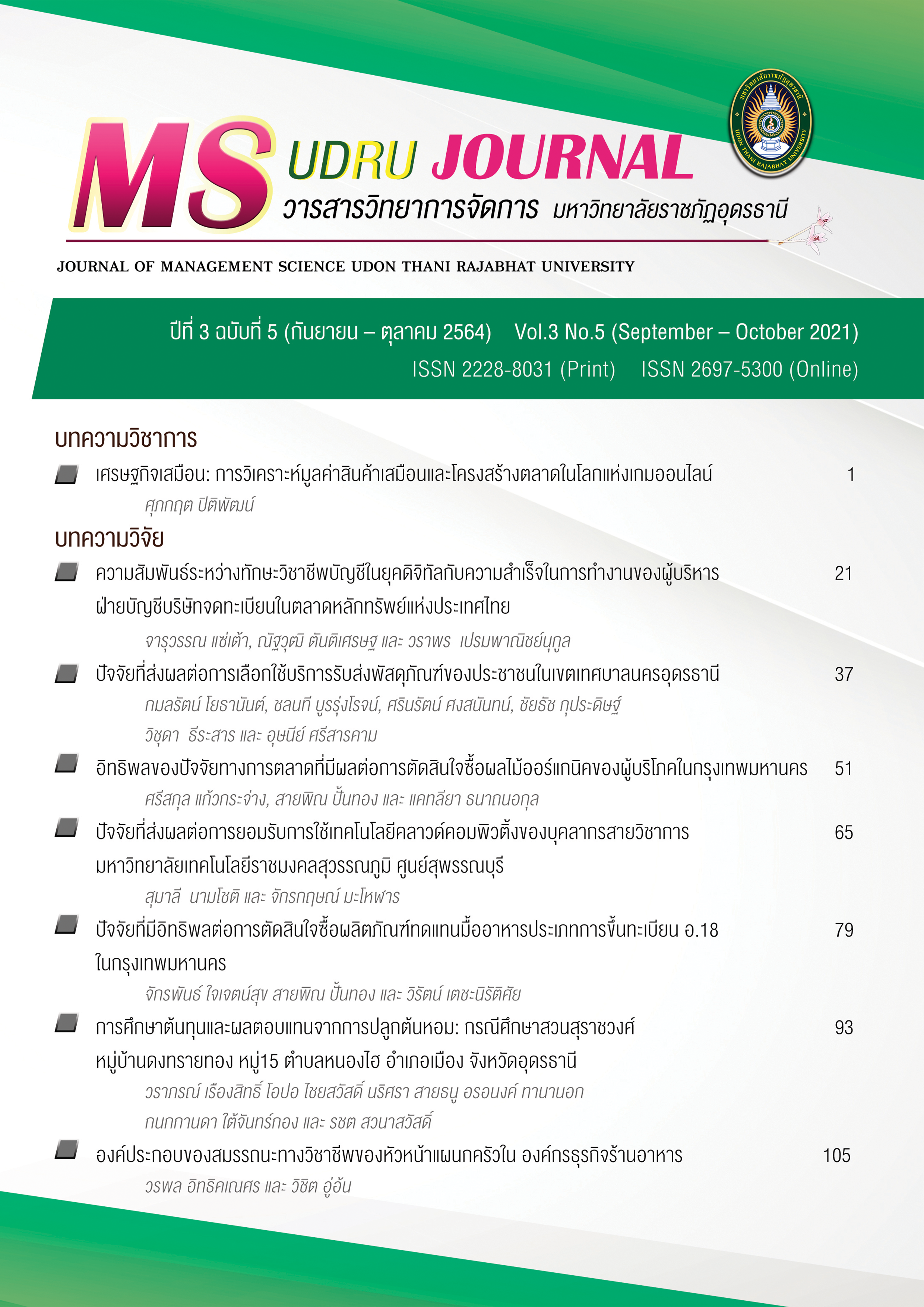เศรษฐกิจเสมือน: การวิเคราะห์มูลค่าสินค้าเสมือนและโครงสร้างตลาดในโลกแห่งเกมออนไลน์
Main Article Content
บทคัดย่อ
เศรษฐกิจเสมือนกำลังเติบโตและมีความสำคัญเพิ่มมากขึ้น ซึ่งส่งผลกระทบต่อเศรษฐกิจในโลกแห่งความเป็นจริง การบริโภคเสมือนมีความเกี่ยวข้องกับการบริโภคสินค้าเสมือนในเกมออนไลน์ กิจกรรมการบริโภคเสมือนกำลังพัฒนาไปสู่กิจกรรมที่มีความจำเป็นในสังคมแห่งโลกเสมือนจริง แม้เศรษฐกิจเสมือนจะมีความสำคัญเพิ่มขึ้น แต่มีงานวิชาการไม่มากนักที่อธิบายถึงปรากฏการณ์ที่เกิดขึ้น บทความนี้ มีวัตถุประสงค์เพื่ออธิบายคุณลักษณะของเศรษฐกิจเสมือน ความหมายของสินค้าเสมือน มูลค่าของสินค้าเสมือน และโครงสร้างตลาดในเกมออนไลน์ โดยวิเคราะห์จากแนวคิด ทฤษฎี และงานวิจัยที่เกี่ยวข้อง ซึ่งทำให้เข้าใจปรากฏการณ์ทางสังคมที่เกิดขึ้นในปัจจุบัน
Article Details

อนุญาตภายใต้เงื่อนไข Creative Commons Attribution-NonCommercial-NoDerivatives 4.0 International License.
บทความที่ได้รับการตีพิมพ์เป็นลิขสิทธิ์ของคณะวิทยาการจัดการ มหาวิทยาลัยราชภัฏอุดรธานี
ข้อความที่ปรากฏในบทความแต่ละเรื่องในวารสารวิชาการเล่มนี้
ไม่ใช่ความคิดเห็นและความรับผิดชอบของผู้จัดทำ บรรณาธิการ กองบรรณาธิการ และคณะวิทยาการจัดการ มหาวิทยาลัยราชภัฏอุดรธานี ความรับผิดชอบด้านเนื้อหาและการตรวจร่างบทความแต่ละเรื่องเป็นความคิดเห็นของผู้เขียนบทความแต่ละท่าน
เอกสารอ้างอิง
สำนักงานส่งเสริมเศรษฐกิจดิจิทัล. (2563). ผลสำรวจข้อมูลและประเมินสถานภาพอุตสาหกรรมดิจิทัล ปี 2651 – 2562 คาดการณ์แนวโน้ม 3 ปี. สืบค้นเมื่อ 16 พฤศจิกายน 2563, จาก https://www.depa.or.th/storage/app/media/file/PressConferenceDepaIMC-DC-BD-20201109.pdf
Amaldoss, W. and Jain, S. (2005). Conspicuous consumption and sophisticated thinking. Management Science, 51(10), 1449–1466.
Barloletti, M., Carta, S., Cimoli, T. and Saia, R. (2020). Dissecting Ponzi schemes on Ethereum: Identification, analysis, and impact. Future Generation Computer Systems, 102(January), 259-277.
Baumer, M. and Kephart, C. (2015). Aggregate dynamics in a large virtual economy: Prices and real activity in Team Fortress 2. California: Department of Economics, University of California Santa Cruz.
Castronova, E. (2002). On virtual economies. Munich, Germany: Center for Economic Studies & Ifo Institute for Economic Research (CESifo).
Castronova, E. (2005). Synthetic worlds: The business and culture of online games. Chicago: University of Chicago.
Chambers, C. (2011). How virtual are virtual economies? An exploration into the legal, social and economic nature of virtual world economies. Computer Law & Security Review, 27(4), 377-384.
Cleghorn, J. and Griffths, M. D. (2015). Why do gamers buy ‘virtual assets’? An insight in to the psychology behind purchase behavior. Digital Education Review, 27(June 2016), 85-104.
Davidovici-Nora, M. (2013). Innovation in business models in the video game industry: Free-to-play or the gaming experience as a service. The Computer Games Journal, 2(3), 22-51.
Dethridge, L. and Quinn, B. (2016). Realtime emergency communication in virtual worlds. International Journal of Disaster Resilience in The Built Environment, 7(1), 26–39.
Fairfield, J. (2005). Virtual property. Boston University Law Review, 85(4), 1047–1102.
Flunger, R., Mladenow, A. and Strauss, C. (2017). The free-to-play business model. In Indrawan-Santiago, M., Salvadori, I. L., Steinbauer, M., Khalil, I. and Anderst-Kotsis, G. (Eds.) The 19th International Conference on Information Integration and Web-Based Applications & Services (iiWAS 2017), pp. 373-379. Salzburg, Austria: Association for Computing Machinery.
GamingScan. (2020). 2020 gaming industry statistics, trends & data. Retrieved May 2, 2021, from https://www.gamingscan.com/gaming-statistics/
Guo, Y., and Barnes, S. (2009). Virtual item purchase behavior in virtual worlds: An exploratory investigation. Electronic Commerce Research, 9(June), 77-96.
Hamari, J. and Lehdonvirta, V. (2010). Game design as marketing: How game mechanics create demand for virtual goods. International Journal of Business Science and Applied Management, 5(1), 14-29.
Hamari, J., Alha, K., Jarvela, S., Kivikangas, J. M., Koivisto, J. and Paavilainen, J. (2017). Why do players buy in-game content? An empirical study on concrete purchase motivations. Computers in Human Behavior, 68(March 2017), 538–546.
Hassouneh, D. and Brengman, A. (2011). Shopping in virtual worlds: Perceptions, motivations, and behavior. Journal of Electronic Commerce Research, 12(4), 320-335.
Huang, E. (2012). Online experiences and virtual goods purchase intention. Internet Research, 22(3), 252-274.
Jankowski, J. (2014). Virtual goods in social media. In R. Alhajj, & J. Rokne (Eds.), Encyclopedia of Social Network Analysis and Mining (pp. 2307-2313), New York: Springer.
Jung, Y. and Pawlowski, S. (2015). The meaning of virtual entrepreneurship in social virtual worlds. Telematics and Informatics, 32(1), 193-203.
Jung, Y. and Pawlowski, S. D. (2014). Understanding consumption in social virtual worlds: A sensemaking perspective on the consumption of virtual goods. Journal of Business Research, 67(10), 2231-2238.
Lehdonvirta, V. (2009). Virtual item sales as a revenue model: Identifying attributes that drive purchase decisions. Electronic Commerce Research, 9(1), 97-113.
Lehdonvirta, V. and Castronova, E. (2014). Virtual economies: Design and analysis. Cambridge, Massachusetts: Massachusetts Institute of Technology.
Lehdonvirta, V. and Ernkvist, M. (2011). Converting the virtual economy into development potential: Knowledge map of the virtual economy. Washington, DC: World Bank.
Li, Z. (2012). Motivation of virtual goods transactions based on the theory of gaming motivations. Journal of Theoretical and Applied Information Technology, 43(2), 254-260.
Lin, H. and Wang, H. (2014). Avatar creation in virtual worlds: Behaviors and motivations. Computers in Human Behavior, 34(May 2014), 213–218.
Linden Labs. (2021). Linden Labs official: live data feeds. Retrieved April 16, 2021, from https://api.secondlife.com/datafeeds/homepage.txt
Mäntymäki, M. and Salo, J. (2011). Teenagers in social virtual worlds: Continuous use and purchasing behavior in Habbo Hotel. Computers in Human Behavior, 27(6), 2088-2097.
Mäntymäki, M. and Salo, J. (2013). Purchasing behavior in social virtual worlds: An examination of Habbo Hotel. International Journal of Information Management, 33(2), 282–290.
Martin, J. (2008). Consuming code: Use-value, exchange-value, and the role of virtual goods in Second Life. Journal of Virtual Worlds Research, 1(2), 1-21.
Nazir, M. and Lui, C. (2016). A brief history of virtual economy. Journal of Virtual Worlds Research, 9(1), 1-24.
Nielsen Sports. (2019). Game changer: Rethinking sports experiences for generation z. New York: Nielsen.
Simmel, G. (1904). Fashion. International Quarterly, 10(1), 130-155.
Stefany, S. (2014). The effect of motivation on purchasing intention of online games and virtual items provided by online game provider. International Journal of Communication & Information Technology, 8(1), 22-27.
Trigg, A. B. (2001). Veblen, Bourdieu, and conspicuous consumption. Journal of Economic Issues, 35(1), 99–115.
Veblen, T. (1912). The theory of the leisure class: An economic study of institutions. New York: B. W. Huebsch.
Verhagen, T., Feldberg, F., Van Den Hooff, B., Meents, S. and Merikivi, J. (2012). Understanding users’ motivations to engage in virtual worlds: A multipurpose model and empirical testing. Computers in Human Behavior, 28(2), 484–495.
Voyager, D. (2021). Second Life stats. Retrieved April 15, 2021, from https://danielvoyager.wordpress.com/sl-stats/
Vyshnevskyi, O. (2019). Unity of digital and virtual economies within concept of dataism. Virtual Economics, 2(3), 7-21.
Yamaguchi, H. (2007). On policy issues “in” virtual worlds: beyond the “seniority-based dragonball economy”. Journal of Digital Games Research, 1(1), 54-64.
Yee, N. (2006). Motivations for play in online games. CyberPsychology & Behavior, 9(6), 772-775.


